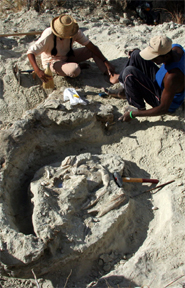 Although museum
drawers may seem to overflow with fossils, paleontologists have long known that
the record of life preserved in the rocks is incomplete. Just how incomplete
the fossil record is, though, has remained a colossal question. Recently, paleontologists
have been working on ways to fill in gaps in life’s diversity record, and
some researchers are finding that climate change — including greenhouse
gas warming — may play a pivotal role in preserving fossil assemblages.
Although museum
drawers may seem to overflow with fossils, paleontologists have long known that
the record of life preserved in the rocks is incomplete. Just how incomplete
the fossil record is, though, has remained a colossal question. Recently, paleontologists
have been working on ways to fill in gaps in life’s diversity record, and
some researchers are finding that climate change — including greenhouse
gas warming — may play a pivotal role in preserving fossil assemblages.Last summer, researchers uncovered the remains of several dinosaurs in this bonebed in northern Madagascar that appear to have perished during drought — just one example of a climatic link to extraordinary fossil preservation. Image courtesy of Raymond Rogers.
Understanding fossil preservation — with a focus on exactly what happens to an organism after its death and until its discovery as a fossil — is important for figuring out potential biases in the fossil record, says Raymond Rogers, a geologist at Macalester College in St. Paul, Minn. “Preservation is what gives us a record,” but natural processes can act to distort the record, he says.
“We all know the record is biased,” says Peter Allison of Imperial College London, who co-chaired a session on preservation biases at the annual meeting of the Geological Society of America (GSA) in Salt Lake City, Utah, in October. “Just go out to any beach and collect shells,” he says. The beach may seem to be teeming with hard-bodied organisms living in the shells, but modern biology says that soft-bodied organisms comprise two-thirds of the community living there. The beach’s tendency to preserve hard-bodied organisms would present a significant bias in the fossil record.
Factors that affect preservation include timing, location, the durability of the organism’s remains, natural disasters and climate. “Certain environments harbor greater diversity than others, and climate will control the distribution of these environments,” says Christopher Noto of Stony Brook University in New York, who presented at the GSA meeting. Climate, Noto says, may also control preservation patterns.
In the Late Jurassic dinosaur record, for example, fewer fossils have been found at higher latitudes of the time — a warmer, wetter environment with higher biological activity — than at lower latitudes where the climate was drier. That pattern, however, may indicate a bias rather than real conditions, Noto says: Tropical regions are some of the worst environments for preservation, despite supporting some of the highest diversity of plant and animal life in the world. Thus, to understand the fossil record and the diversity at any given time, “we need to gain insight into conditions” at the time and “match them up with the fossil record,” he says.
Greg Retallack of the University of Oregon in Eugene, also presenting at the GSA meeting, suggested that climate, and specifically global warming, may have contributed to fossil preservation. Retallack scanned through a database of 500 million years’ worth of fossils and found 41 individual episodes of “exceptional preservation” of organisms such as fish, crustaceans, insects and starfish scattered throughout the world.
Retallack took those 41 locations, including well-known and well-dated sites, such as the 508-million-year-old Burgess Shale in Canada and the 123-million-year-old Liaoning site in China, and compared them to climate records over the same time periods. He found that during each peak in the fossil record, there was a corresponding spike in atmospheric carbon dioxide and methane levels, and a spike in precipitation levels and temperatures. It appears, he said, that “greenhouse episodes” may have occurred simultaneously with the “mass kills.”
However, the question remains which came first: whether the greenhouse gas episodes preserved the fossils, or whether the episodes simply killed many life forms and thus left more to be preserved. “With a mass kill, there’s obviously a better chance of preservation because scavengers are overwhelmed, and they can’t completely recycle or consume” the bodies, Rogers says.
The dinosaur record from Madagascar, for example, has shown a strong correlation to climate, he says. In a 15-meter-thick section of rock that contains several distinct dinosaur bonebeds, Rogers and colleagues also found evidence of recurring severe droughts followed by extreme rainy periods that promoted burial — a link between climate conditions, mass death and preservation.
While Noto and Retallack pose “interesting ideas,” Allison says, more data is needed on how preservation and biases changed through time. Until researchers have that information, he says, refining the record of life’s diversity over time will be difficult.

